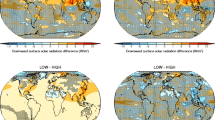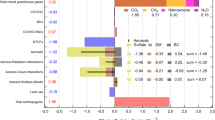Abstract
This study assesses the direct and indirect effects of natural and anthropogenic aerosols (e.g., black carbon and sulfate) over West and Central Africa during the West African monsoon (WAM) period (June–July–August). We investigate the impacts of aerosols on the amount of cloudiness, the influences on the precipitation efficiency of clouds, and the associated radiative forcing (direct and indirect). Our study includes the implementation of three new formulations of auto-conversion parameterization [namely, the Beheng (BH), Tripoli and Cotton (TC) and Liu and Daum (R6) schemes] in RegCM4.4.1, besides the default model’s auto-conversion scheme (Kessler). Among the new schemes, BH reduces the precipitation wet bias by more than 50% over West Africa and achieves a bias reduction of around 25% over Central Africa. Results from detailed sensitivity experiments suggest a significant path forward in terms of addressing the long-standing issue of the characteristic wet bias in RegCM. In terms of aerosol-induced radiative forcing, the impact of the various schemes is found to vary considerably (ranging from −5 to −25 W m−2).
摘要
本研究评估了西非季风时段 (6 月-8 月) 非洲西部和中部地区自然和人为 (例如, 黑炭和硫酸盐) 气溶胶的直接和间接效应. 除了针对 RegCM 4.4.1 模式默认的 Kessler 云水自动转换方案进行评估外, 还比对了 Beheng(BH), Tripoli and Cotton (TC) 和 Liu and Daum (R6) 三种新的参数化方案. 通过比对这些方案, 分析了气溶胶对云量的影响, 对云的降水效率的影响及其相应的直接和间接辐射强迫. 在三种新的方案中, BH 方案明显减少了模拟结果中湿度的偏差, 在西非和中非区域的模拟偏差分别降低了 50%和 25%. 敏感性试验表明, 这一方案为解决 RegCM 模式一直存在的湿度偏差问题向前推进了一大步. 另外, 不同的参数化方案模拟的气溶胶辐射效应有很大差别, 在-5 至-25 W m-2浮动.
Similar content being viewed by others
References
Albrecht, B. A., 1989: Aerosols, cloud microphysics, and fractional cloudiness. Science, 245, 1227–1230, https://doi.org/10.1126/science.245.4923.1227.
Beheng, K. D., 1994: A parameterization of warm cloud microphysical conversion processes. Atmo. Res., 33, 193–206, https://doi.org/10.1016/0169-8095(94)90020-5.
Chiapello, I., C. Moulin, and J. M. Prospero, 2005: Understanding the long-term variability of African dust transport across the Atlantic as recorded in both Barbados surface concentrations and large-scale total ozone mapping spectrometer (TOMS) optical thickness. J. Geophys. Res., 110, D18S10, https://doi.org/10.1029/2004JD005132.
Costantino, L., and F. M. Bréon, 2013: Aerosol indirect effect on warm clouds over South-East Atlantic, from co-located MODIS and CALIPSO observations. Atmospheric Chemistry and Physics, 13, 69–88, https://doi.org/10.5194/acp-13-69-2013.
Dickinson, R. E., Henderson-Sellers, A., and P. J. Kennedy, 1993: Biosphere-atmosphere transfer scheme (BATS) version 1e as coupled to the NCAR community climate model. National Center for Atmospheric Research Technical Note NCAR. TN-387+STR, 72 pp.
Emmons, L. K., and Coauthors, 2010: Description and evaluation of the Model for Ozone and Related chemical Tracers, version 4 (MOZART-4). Geoscientific Model Development, 3, 43–67, https://doi.org/10.5194/gmd-3-43-2010.
Fan, J. W., Y. Wang, D. Rosenfeld, and X. H. Liu, 2016: Review of aerosol-cloud interactions: Mechanisms, significance, and challenges. J. Atmos. Sci., 73, 4221–4252, https://doi.org/10.1175/JAS-D-16-0037.1.
Fritsch, J. M., and C. F. Chappell, 1980: Numerical prediction of convectively driven mesoscale pressure systems. Part 1: Convective parameterization. J. Atmos. Sci., 37, 1722–1733, https://doi.org/10.1175/1520-0469(1980)037<1722:NPOCDM>2.0.CO;2.
Gautam, R., and Coauthors, 2011: Accumulation of aerosols over the Indo-Gangetic plains and southern slopes of the Himalayas: Distribution, properties and radiative effects during the 2009 pre-monsoon season. Atmos. Chem. Phys., 11, 12 841–12 863, https://doi.org/10.5194/acp-11-12841-2011.
Giorgi, F., 1989: Two-dimensional simulations of possible mesoscale effects of nuclear war fires. I: Model description. J. Geophys. Res., 94, 1127–1144, https://doi.org/10.1029/JD094iD01p01127.
Giorgi, F., and W. L. Chameides, 1986: Rainout lifetimes of highly soluble aerosols and gases as inferred from simulations with a general circulation model. J. Geophys. Res., 91, 14 367–14 376, https://doi.org/10.1029/JD091iD13p14367.
Giorgi, F., and Coauthors, 2012: RegCM4: Model description and preliminary tests over multiple CORDEX domains. Climate Research, 52, 7–29, https://doi.org/10.3354/cr01018.
Giorgi, F., M. R. Marinucci, and G. T. Bates, 1993: Development of a second-generation regional climate model (RegCM2). Part I: Boundary-layer and radiative transfer processes. Mon. Wea. Rev., 121, 2794–2813, https://doi.org/10.1175/1520-0493(1993)121<2794:DOASGR>2.0.CO;2.
Grell, G. A, 1993: Prognostic evaluation of assumptions used by cumulus parameterizations. Mon. Wea. Rev., 121, 764–787, https://doi.org/10.1175/1520-0493(1993)121<0764:PEOAUB>2.0.CO;2.
Gu, Y., K. N. Liou, J. H. Jiang, H. Su, and X. Liu, 2012: Dust aerosol impact on North Africa climate: A GCM investigation of aerosol-cloud-radiation interactions using A-Train satellite data. Atmos. Chem. Phy. Discuss., 11, 1667–1679, https://doi.10.5194/acpd-11-31401-2011.
Gu, Y., K. N. Liou, Y. Xue, C. R. Mechoso, W. Li, and Y. Luo, 2006: Climatic effects of different aerosol types in China simulated by the UCLA general circulation model. J. Geophys. Res., 111, D15201, https://doi.org/10.1029/2005JD006312.
Gultepe, I., and G. A. Isaac, 1997: Liquid water content and temperature relationship from aircraft observations and its applicability to GCMs. J. Climate, 10, 446–452, https://doi.org/10.1175/1520-0442(1997)010<0446:LWCATR>2.0.CO;2.
Hegg, D. A., 1994: Cloud condensation nucleus-sulphate mass relationship and cloud albedo. J. Geophys. Res., 99, 25 903–25 907, https://doi.org/10.1029/94JD02224.
Holtslag, A. A. M., E. I. F. de Bruijn, and H. L. Pan, 1990: A high resolution air mass transformation model for short-range weather forecasting. Mon. Wea. Rev., 118, 1561–1575, https://doi.org/10.1175/1520-0493(1990)118<1561:AHRAMT>2.0.CO;2.
Hsu, N. C., S. C. Tsay, M. D. King, and J. R. Herman, 2006: Deep blue retrievals of Asian aerosol properties during ACEAsia. IEEE Trans. Geosci. Remote Sens., 44, 3180–3195, https://doi.org/10.1109/TGRS.2006.879540.
Huang, J. F., C. D. Zhang, and J. M. Prospero, 2009: African aerosol and large-scale precipitation variability over West Africa. Environ. Res. Lett., 4, 015006, https://doi.org/10.1088/1748-9326/4/1/015006.
Huang, Y., 2005: Assessments of the direct and indirect effects of anthropogenic aerosols on regional precipitation over east Asia using a coupled regional climate-chemistry-aerosol model. PhD dissertation, Georgia Institute of Technology.
Huang, Y., W. L. Chameides, and R. E. Dickinson, 2007: Direct and indirect effects of anthropogenic aerosols on regional precipitation over east Asia. J. Geophys. Res., 112, D03212, https://doi.org/10.1029/2006JD007114.
IPCC, 2013: Climate Change 2013: The Physical Science Basis. Contribution of Working Group I to the Fifth Assessment Report of the Intergovernmental Panel on Climate Change. Cambridge University Press, 1535 pp.
Ji, Z. M., G. L. Wang, J. S. Pal, and M. Yu, 2016: Potential climate effect of mineral aerosols overWest Africa. Part I: Model validation and contemporary climate evaluation. Climate Dyn., 46, 1223–1239, https://doi.org/10.1007/s00382-015-2641-y.
Kessler, E., 1969: On the distribution and continuity of water substance in atmospheric circulations. Meteorological Monographs. Vol. 10, American Meteorological Society, 84 pp, https://doi.org/10.1007/978-1-935704-36-21.
Kiehl, J. T., J. J. Hack, G. B. Bonan, B. A. Boville, B. P. Briegleb, D. L. Williamson, and P. J. Rasch, 1996: Description of the NCAR community climate model (CCM3). Technical Report NCAR/TN-420+STR.
Kim, K. M., W. K. M. Lau, Y. C. Sud, and G. K. Walker, 2010: Influence of aerosol-radiative forcings on the diurnal and seasonal cycles of rainfall over West Africa and Eastern Atlantic Ocean using GCM simulations. Climate Dyn., 35(1), 115–126, https://doi.org/10.1007/s00382-010-0750-1.
Kodros, J. K., C. E. Scott, S. C. Farina, Y. H. Lee, C. L’Orange, J. Volckens, and J. R. Pierce 2015: Uncertainties in global aerosols and climate effects due to biofuel emissions, Atmos. Chem. Phys., 15, 8577–8596, https://doi.org/10.5194/acp-15-8577-2015.
Konare, A., A. S. Zakey, F. Solmon, F. Giorgi, S. Rauscher, S. Ibrah, and X. Bi, 2008: A regional climate modeling study of the effect of desert dust on the West African monsoon. J Geophys. Res., 113: D12206, https://doi.org/10.1029/2007JD009322.
Levy, R. C., L. A. Remer, S. Mattoo, E. F. Vermote, and Y. J. Kaufman, 2007: Second-generation operational algorithm: Retrieval of aerosol properties over land from inversion of Moderate Resolution Imaging Spectroradiometer spectral reflectance. J. Geophys. Res., 112, D13211, https://doi.org/10.1029/2006JD007811.
Liu, Y. G., and P. H. Daum, 2004: Parameterization of the autoconversion process. Part I: Analytical formulation of the Kessler-type parameterizations. J. Atmos. Sci., 61, 1539–1548, https://doi.org/10.1175/1520-0469(2004)061<1539:POTAPI>2.0.CO;2.
Liu, Y. G., P. H. Daum, and R. McGraw, 2004: An analytical expression for predicting the critical radius in the autoconversion parameterization. Geophys. Res. Lett., 31, L06121, https://doi.org/10.1029/2003GL019117.
Liu, Y. G., P. H. Daum, R. L. McGraw, M. A. Miller, and S. J. Niu, 2007: Theoretical expression for the autoconversion rate of the cloud droplet number concentration. Geophys. Res. Lett., 34, L16821, https://doi.org/10.1029/2007GL030389.
Lohmann, U., and J. Feichter, 1997: Impact of sulfate aerosols on albedo and lifetime of clouds: A sensitivity study with the ECHAM4 GCM. J. Geophys. Res., 102, 13 685–13 700, https://doi.org/10.1029/97JD00631.
Martin, G. M., D. W. Johnson, and A. Spice, 1994: The measurement and parameterization of effective radius of droplets in warm stratocumulus clouds. J. Atmos. Sci., 51, 1823–1842, https://doi.org/10.1175/1520-0469(1994)051<1823:TMAPOE>2.0.CO;2.
Mitchell, T. D., and P. D. Jones, 2005: An improved method of constructing a database of monthly climate observations and associated high-resolution grids. International Journal of Climatology, 25(6), 693–712, https://doi.org/10.1002/joc.1181.
Olivier, J. G. J., J. J. M. Berdowski, J. A. H. W. Peters, J. Bakker, A. J. H. Visschedijk, and J.-P. J. Bloos, 2001: Applications of EDGAR. Including a description of EDGAR 3.0: Reference database with trend data for 1970-1995. RIVM, Bilthoven. RIVM report no. 773301 001/NOP report no. 410200 051.
Pal, J. S., E. E. Small, and E. A. B. Eltahir, 2000: Simulation of regional-scale water and energy budgets: Representation of subgrid cloud and precipitation processes within RegCM. J. Geophys. Res., 105, 29 579–29 594, https://doi.org/10.1029/2000JD900415.
Pruppacher, H. R., and J. D. Klett, 1997: Microphysics of Clouds and Precipitation. 2nd ed., Springer, 954 pp.
Qian, Y., and F. Giorgi, 1999: Interactive coupling of regional climate and sulfate aerosol models over eastern Asia. J. Geophys. Res., 104, 6477–6499, https://doi.org/10.1029/98JD02347.
Rogers, R. R., and M. K. Yau, 1989: A Short Course in Cloud Physics. 3rd ed., Oxford, Pergamon, UK.
Rotstayn, L. D., and Y. G. Liu, 2005: A smaller global estimate of the second indirect aerosol effect. Geophys. Res. Lett., 32, L05708, https://doi.org/10.1029/2004GL021922.
Schultz, M. G., and Coauthors, 2007: REanalysis of the TROpospheric chemical composition over the past 40 years— A long-term global modeling study of tropospheric chemistry funded under the 5th EU Framework Programme 2007. Technical Report, EU-Contract No. EVK2-CT-2002-00170, 20 pp. [Available online at http://retro.enes.org/reports/D1–6 final.pdf]
Seinfeld, J. H., and S. N. Pandis, 2006: Atmospheric Chemistry and Physics: From Air Pollution to Climate Change. 2nd ed., Wiley-Interscience.
Solmon, F., F. Giorgi, and C. Liousse, 2006: Aerosol modelling for regional climate studies: Application to anthropogenic particles and evaluation over a European/African domain. Tellus, 58B, 51–72, https://doi.org/10.1111/j.1600-0889.2005.00155.x.
Solmon, F., N. Elguindi, and M. Mallet, 2012: Radiative and climatic effects of dust over West Africa, as simulated by a regional climate model. Climate Research, 52, 97–113, https://doi.org/10.3354/cr01039.
Sylla, M. B., E. Coppola, L. Mariotti, F. Giorgi, P. M. Ruti, A. Dell’Aquila, and X. Bi, 2010: Multiyear simulation of the african climate using a regional climate model (RegCM3) with the high resolution ERA-interim reanalysis. Climate Dyn., 35, 231–274, https://doi.org/10.1007/s00382-009-0613-9.
Tripoli, G. J., and W. R. Cotton, 1980: A numerical investigation of several factors contributing to the observed variable intensity of deep convection over South Florida. J. Atmos. Sci., 19, 1037–1063, https://doi.org/10.1175/1520-0450(1980)019<1037:ANIOSF>2.0.CO;2.
Twomey, S., 1977: The influence of pollution on the shortwave albedo of clouds. J. Atmos. Sci., 34, 1149–1152, https://doi.org/10.1175/1520-0469(1977)034<1149:TIOPOT>2.0.CO;2.
Acknowledgements
The authors would like to thank both of the NOAA/OAR/ESRL PSD, Boulder, Colorado, USA, for providing the NCEP Reanalysis 2 data on their web site at http://www.esrl.noaa.gov/psd/, and ICTP on their website at http://clima-dods.ictp.it/data/regcm4/NNRP2/.
Author information
Authors and Affiliations
Corresponding author
Rights and permissions
About this article
Cite this article
Salah, Z., Shalaby, A., Steiner, A.L. et al. Study of aerosol direct and indirect effects and auto-conversion processes over the West African monsoon region using a regional climate model. Adv. Atmos. Sci. 35, 182–194 (2018). https://doi.org/10.1007/s00376-017-7077-3
Received:
Revised:
Accepted:
Published:
Issue Date:
DOI: https://doi.org/10.1007/s00376-017-7077-3




